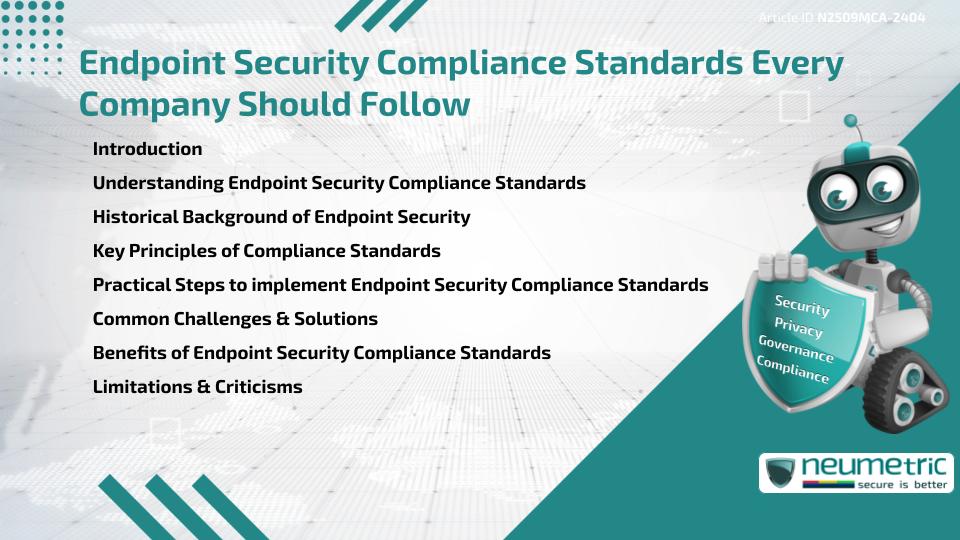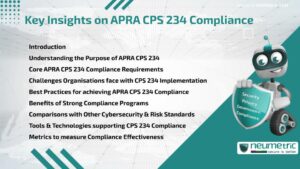Table of Contents
ToggleIntroduction
Endpoint Security Compliance standards are critical for safeguarding devices that connect to organisational networks. These standards ensure protection against unauthorised Access, Malware & Data Breaches. By following Endpoint Security Compliance standards, companies strengthen defenses, meet Regulatory requirements & build Trust with Stakeholders. This article explores their background, key principles, practical steps, challenges, benefits & criticisms.
Understanding Endpoint Security Compliance Standards
Endpoint Security Compliance standards outline the requirements Organisations must follow to secure devices such as laptops, desktops, mobile phones & servers. These standards cover areas like Access Control, Encryption, Monitoring & Patch Management. Compliance ensures devices remain secure entry points to Networks & Data Systems.
Historical Background of Endpoint Security
Endpoint Security has evolved from traditional antivirus programs in the 1990s to advanced frameworks integrating detection, response & Compliance Requirements. The rise of remote work & mobile devices expanded the attack surface, prompting Organisations & Regulators to adopt stricter Endpoint Security Compliance standards.
Key Principles of Compliance Standards
The key principles of Endpoint Security Compliance standards include:
- Strong Authentication & Access Controls
- Encryption of Sensitive Data
- Timely Patching & Vulnerability management
- Continuous Monitoring & Logging
- Incident detection & response mechanisms
These principles help ensure that devices remain resilient against Threats while aligning with Industry Regulations.
Practical Steps to implement Endpoint Security Compliance Standards
Organisations can apply Endpoint Security Compliance standards through:
- Conducting Risk Assessments to identify Vulnerable endpoints
- Enforcing Multi-factor Authentication & strict Access Policies
- Regularly updating & patching systems
- Encrypting Sensitive files & communications
- Monitoring endpoints using Security Information & Event Management [SIEM] tools
- Training Employees on Endpoint Security practices
Embedding these measures into daily operations ensures sustainable Compliance.
Common Challenges & Solutions
Common challenges include managing diverse devices, integrating security in remote work environments & keeping pace with evolving Threats. Solutions involve using centralised endpoint management systems, applying Zero Trust principles & automating updates & monitoring to reduce human error.
Benefits of Endpoint Security Compliance Standards
Key benefits of implementing Endpoint Security Compliance standards are:
- Reduced Risks of Malware & Ransomware attacks
- Stronger Compliance with Data Protection regulations
- Improved Customer & Stakeholder Trust
- Enhanced visibility & control over IT assets
- Better Incident Response readiness
Limitations & Criticisms
Some argue that Endpoint Security Compliance standards can be resource-intensive, particularly for smaller businesses. Others highlight that Compliance does not guarantee immunity from attacks. A balanced approach focusing on practical Risk reduction alongside Compliance is essential.
Conclusion
Endpoint Security Compliance standards provide Organisations with the foundation to protect critical devices & data. While challenges exist, the benefits far outweigh limitations, making these standards indispensable for modern businesses.
Takeaways
- Endpoint Security Compliance standards safeguard devices from Threats.
- Key principles include Access Control, Encryption, Patching & Monitoring.
- Practical steps involve Risk Assessments, Multi-factor Authentication & SIEM tools.
- Challenges include managing diverse devices, but solutions such as automation help.
- Benefits include stronger Compliance, reduced Risks & improved Trust.
FAQ
What are Endpoint Security Compliance standards?
They are guidelines & requirements that ensure organisational endpoints are secure & protected against Threats.
Why are Endpoint Security Compliance standards important?
They help prevent Breaches, ensure Regulatory Compliance & protect Sensitive Data.
Who needs to follow Endpoint Security Compliance standards?
All Organisations with devices connecting to their networks, regardless of size or industry, should follow them.
How can Organisations implement Endpoint Security Compliance standards?
By applying Access Controls, Patching systems, Encrypting data & using Monitoring Tools.
What challenges exist in applying Endpoint Security Compliance standards?
Challenges include managing remote devices, maintaining updates & addressing evolving Threats.
Are Endpoint Security Compliance standards mandatory?
While not always legally required, many industries mandate them through regulations & contracts.
How often should endpoint Security Measures be reviewed?
They should be reviewed continuously, with regular Audits & updates to address new Risks.
Do Endpoint Security Compliance standards guarantee complete security?
No, they reduce Risks significantly but must be combined with broader Security Practices.
Need help for Security, Privacy, Governance & VAPT?
Neumetric provides organisations the necessary help to achieve their Cybersecurity, Compliance, Governance, Privacy, Certifications & Pentesting needs.
Organisations & Businesses, specifically those which provide SaaS & AI Solutions in the Fintech, BFSI & other regulated sectors, usually need a Cybersecurity Partner for meeting & maintaining the ongoing Security & Privacy needs & requirements of their Enterprise Clients & Privacy conscious Customers.
SOC 2, ISO 27001, ISO 42001, NIST, HIPAA, HECVAT, EU GDPR are some of the Frameworks that are served by Fusion – a SaaS, multimodular, multitenant, centralised, automated, Cybersecurity & Compliance Management system.
Neumetric also provides Expert Services for technical security which covers VAPT for Web Applications, APIs, iOS & Android Mobile Apps, Security Testing for AWS & other Cloud Environments & Cloud Infrastructure & other similar scopes.
Reach out to us by Email or filling out the Contact Form…





